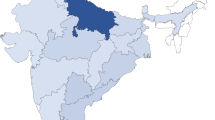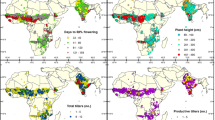Abstract
Pigeonpea germplasm accessions collected from low (<500 m), medium (501–1000 m), high (1001–1500 m) and very high elevation zones (>1500 m) of Kenya were evaluated for 15 agronomic traits and seed protein content at ICRISAT, Patancheru, India. There were significant differences (P < 0.001) among elevation zones for the number of primary and secondary branches, days to 75% maturity, pod length, seeds per pod, 100-seed weight and seed yield. Mean values indicated that the accessions from low elevation zone were significantly different from those collected in higher elevation zones for early flowering and maturity, number of primary branches, pod length, number of pods per plant, seeds per pod, 100-seed weight, seed yield and harvest index. None of the accessions collected in Kenya belonged to extra early (<80 days to 50% flowering) and early (80–100 days to 50% flowering) maturity groups, as defined by time to flowering at Patancheru, India. Mean diversity index based on all characters indicated that accessions from the low elevation zone are more diverse than those from the higher elevation zones. Frequency distribution for trait extremes indicated that the accessions from the low elevation zone were early to flower and mature, short statured, produced more primary and secondary branches with high pod bearing length, long pods, more pods per plant, more seeds per pod, a high seed yield and harvest index. Accessions from the very high elevation zone were late flowering, with a large number of tertiary branches, large seeds and a high shelling percentage and could be a source for cold tolerance and the breeding of vegetable types. Results suggest that the elevation of collection sites is therefore a very important determinant of variation patterns of pigeonpea in Kenya.


Similar content being viewed by others
References
Food and Agriculture Organization (2005) http://www/FAO.ORG/FAOSTAT database
Gooding HJ (1962) The agronomic aspects of pigeonpeas. Field Crop Abstracts 15:1–5
Gupta SC, Singh L, Ariyanayagam RP (1991) Adaptation of short-duration pigeonpea to higher latitudes and altitudes. Int Pigeonpea Newslett 13, Feb 1991
Hayward MD, Breese EL (1993) Population structure and variability. In: Hayward MD, Bosemark NO, Romagosa I (eds) Plant breeding principles and prospects. Chapman & Hall, London, pp 16–29
Hijmans RJ, Gaurino L, Rajas E (2002) Diva-GIS. Version 2. A geographic information system for analysis of biodiversity data. Manual. International Potato Center, Lima, Peru
IBPGR and ICRISAT (1993) Descriptors for Pigeonpea [Cajanus cajan (L.) Millsp.]. International Board for Plant Genetic Resources, Rome, Italy. International Crops Research Institute for the Semi-Arid Tropics, Patancheru, India
ICRISAT (International Crops Research Institute for the Semi-Arid Tropics) (1978) Annual Report 1977/78. Patancheru, AP 502 324, India, ICRISAT, p 295
Keuls M (1952) The use of the “Studentized range” in connection with an analysis of variance. Euphytica 1:112–122
Levene H (1960) Robust tests for equality of variances. In: Oklin I (ed) Contributions to probability and statistics. Essays in honor of Harold Hotelling. Stanford University Press, Stanford, pp 278–292
Newman D (1939) The distribution of range in samples from a normal population expressed in terms of an independent estimate of standard deviation. Biometrika 31:20–30
Ong CK, Monteith JL (1985) Response of pearl millet to light and temperature. Field Crops Res 11:141–160
Remanandan P (1990) Pigeonpea: genetic resources. In: Nene YL, Hall SD, Shiela VK (eds) The pigeonpea. CAB International, Wallingford, Oxon OX 10 8DE, UK, pp 89–115
Remanandan P, Omanga PGA, Shakoor A, Mengesha MH, Sastry DVSSR (1991) Regional pigeonpea germplasm evaluation in Kenya. In: Singh L, Silim SN, Ariyanayagam RP, Reddy MV (eds). Proceedings of the first Eastern and Southern Africa Regional Legumes (Pigeonpea) workshop, 25–27 Jun 1990, Nairobi, Kenya. PO Box 39063, Nairobi, Kenya: Eastern Africa Regional Cereals and Legumes (EARCAL) Program, International Crops Research Institute for the Semi-Arid Tropics
Remanandan P, Shakoor A, Ngugi ECK (1982) Pigeonpea germplam collection mission in Kenya. Genetic Resources Progress Report No. 48, ICRISAT, Patancheru, India
Shannon CE, Weaver W (1949) The mathematical theory of communication. Univ. Illinois Press, Urbana
Singh U, Jambunathan R (1980) Evaluation of rapid methods for estimation of protein in chickpea (Cicer arietinum (L.). J Sci Food Agric 31:247–254
Spence JA, Williams SJA (1972) Use of photoperiod response to change plant design. Crop Sci 12:121–122
van der Maesen LJG (1976) Pigeonpea collection trip in Kenya. Genetic Resources Progress Report, ICRISAT, Patancheru
Whiteman PC, Byth DE, Wallis ES (1985) Pigeonpea [Cajanus cajan (L.) Millisp.]. In: Summerfield RJ, Roberts EH (eds) Grain legume crops. Collins Professional and Technical Books, London, pp 685–698
Author information
Authors and Affiliations
Corresponding author
Rights and permissions
About this article
Cite this article
Upadhyaya, H.D., Reddy, K.N., Gowda, C.L.L. et al. Patterns of diversity in pigeonpea (Cajanus cajan (L.) Millsp.) germplasm collected from different elevations in Kenya. Genet Resour Crop Evol 54, 1787–1795 (2007). https://doi.org/10.1007/s10722-006-9198-x
Received:
Accepted:
Published:
Issue Date:
DOI: https://doi.org/10.1007/s10722-006-9198-x




